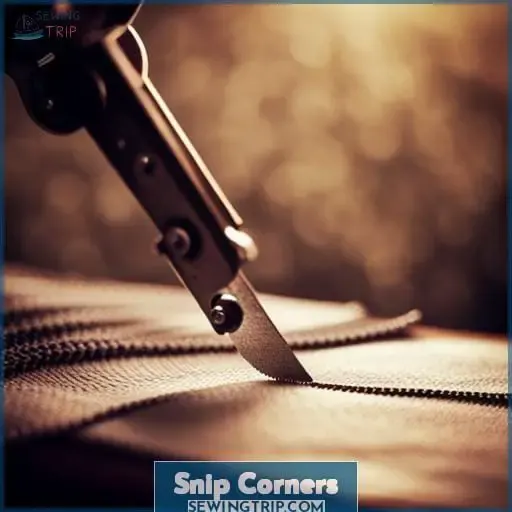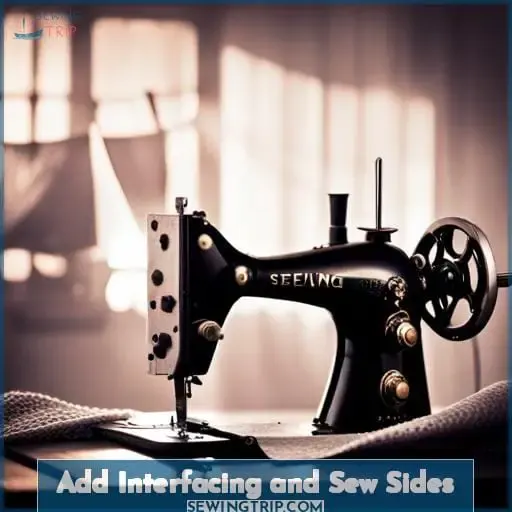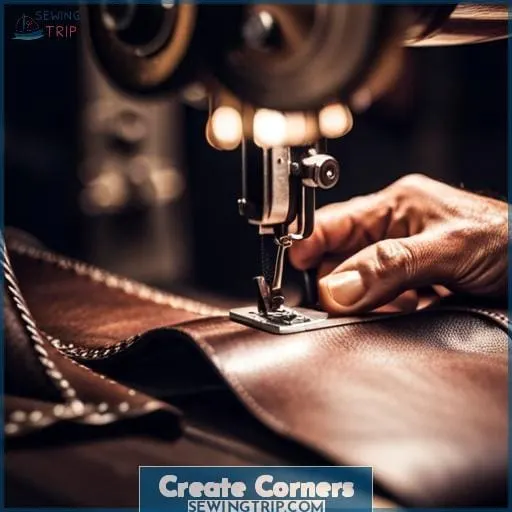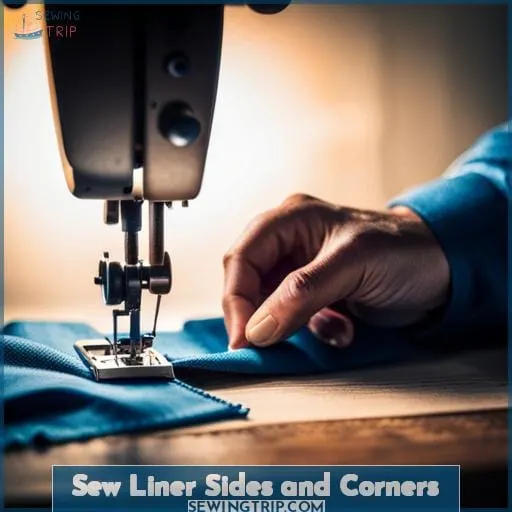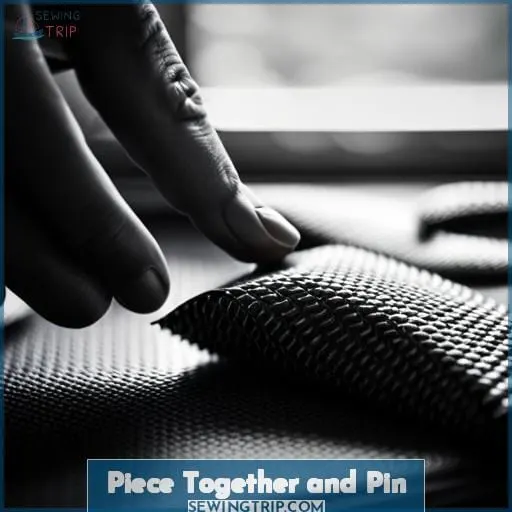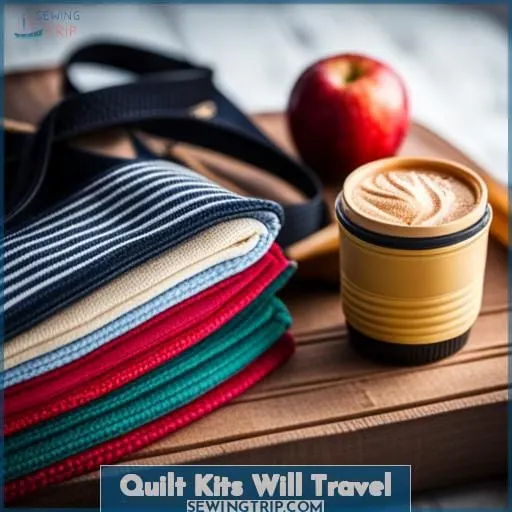This site is supported by our readers. We may earn a commission, at no cost to you, if you purchase through links.
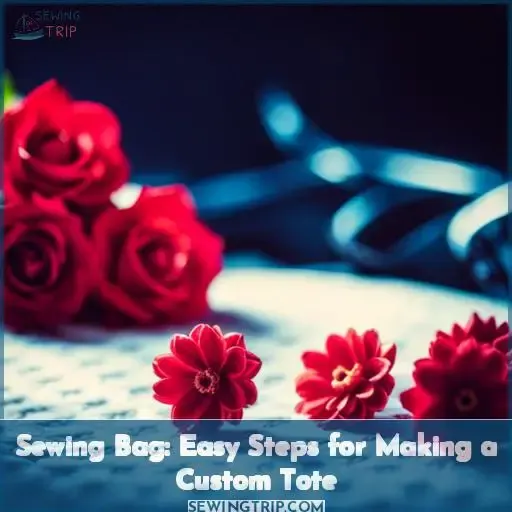 Imagine the satisfaction of strolling down the street, confidently carrying a custom tote bag that you made yourself. With just a few easy steps, you can transform fabric and thread into a stylish accessory that showcases your unique style and craftsmanship.
Imagine the satisfaction of strolling down the street, confidently carrying a custom tote bag that you made yourself. With just a few easy steps, you can transform fabric and thread into a stylish accessory that showcases your unique style and craftsmanship.
In this article, we’ll guide you through the process of sewing a bag from start to finish, empowering you to create something truly one-of-a-kind.
Let’s get started on your journey to tote-making mastery!
Table Of Contents
Key Takeaways
- Cut small squares from the bottom corners of all rectangles.
- Press the interfacing onto the wrong side of the outer fabric.
- Pin together the right sides of your outer fabric before sewing along the sides and bottom.
- Consider adding custom embellishments such as appliqués or embroidery for personalization.
Snip Corners
To begin creating your custom tote bag, it’s essential to snip the corners of the fabric rectangles.
Precision snipping of these corners is a crucial step in achieving a professional and polished finish for your sewing project.
By carefully cutting small squares from the bottom corners of all rectangles, you’ll create corner details that allow for proper shaping and structure when assembling the bag.
This snip technique unveils hidden potential in your fabric pieces and sets the foundation for a well-constructed tote.
Attention to detail during this process ensures neat edges and clean lines throughout your project.
So grab your scissors with confidence, knowing that each corner cut brings you one step closer to mastering this sewing skill and unleashing creativity through beautifully crafted bags.
Add Interfacing and Sew Sides
To add stability and structure to your tote bag, press the interfacing onto the wrong side of the outer fabric. This will provide reinforcement and ensure a professional finish for your DIY project.
After applying the interfacing, pin together the right sides of your outer fabric before sewing along the sides and bottom. By following these stitching strategies, you’ll create strong seams that can withstand everyday use.
Incorporating proper interfacing techniques is essential for achieving a durable tote bag that will last for years to come.
Don’t forget to press open your seams after sewing them together – this small step adds an extra touch of polish to your finished product.
With these steps complete, you’re one step closer to creating a custom tote that combines both functionality and style.
Create Corners
Pinch and align the snipped corners, then sew a 1/2 inch seam.
This step is crucial for creating well-defined corners that add dimension to your tote bag. By carefully folding and sewing the corners, you shape your bag into a functional and stylish accessory.
To ensure precision in corner folding, use shaping techniques such as pressing with an iron or using a chalk roller wheel to mark fold lines. These dimensional details will help guide your snipping process for accurate results.
Once you’ve aligned the corners, secure them with pins before sewing along the folded edges.
Remember to repeat this process for both outer fabric and inner fabric pieces of your sewing bag. Taking time to perfect these corner folds will enhance the overall structure of your tote while showcasing attention to detail in every stitch.
Key Tools
| Key Tools | Description |
|---|---|
| Sewing Bag | The main item being created; serves as an everyday carry-all |
| Canvas Straps | Sturdy handles that provide durability and comfort when carrying heavy items |
Using Fiskars scissors ensures clean cuts on all fabrics involved during this stage—precision snipping plays a significant role at this point! Once you have completed stitching around each corner, turn over everything inside out through one of those unsewn gaps located near where straps are inserted between layers so they can be seen from outside too – it’s now time we move onto turning & pressing next section
Sew Liner Sides and Corners
Sewing the liner sides and corners is an essential step in creating a custom tote bag for all your sewing needs. With precision stitching and careful attention to detail, you can ensure that your tote bag isn’t only functional but also beautifully crafted.
Start by applying interfacing to the wrong side of the outer fabric, following proper interfacing techniques.
Then, pin right sides of the outer fabric together and sew along the sides and bottom with a 1/2 inch seam allowance, leaving the top open for later placement of liners.
Don’t forget to snip small squares from each corner before pressing seams open for a polished look.
Once both outer fabric pieces are complete, repeat these steps with inner fabric so that it mirrors your exterior piece perfectly before assembling them together in their final form.
Piece Together and Pin
Now that you have sewn the sides and corners of the liner, it’s time to piece together the outer fabric and lining for your custom tote.
- Choose complementary fabric combinations for a visually appealing tote.
- Utilize pinning techniques to secure the layers in place before sewing.
- Consider adding custom embellishments such as appliques or embroidery for personalization.
- Pay attention to color coordination between fabrics and embellishments for a cohesive look.
-Take advantage of top-stitching tips, like using thread conditioner, magnetic needle minder, or hera marker.
By carefully piecing together your bag with precision pinning techniques and incorporating unique design elements like custom embellishments and coordinated colors, you’ll create a beautiful finished product.
Sew Bag Opening
To sew the bag opening, start by:
- Aligning the pinned fabric edges.
- Securing them with a straight stitch.
This step ensures that your tote bag has a clean and professional finish.
Once you have stitched along the edge, it’s time to explore different topstitching techniques to enhance the look of your bag.
Consider using contrasting thread or decorative stitches for added visual interest.
When choosing fabrics for your custom tote, opt for sturdy materials like canvas or denim that can withstand daily use.
Additionally, think about closure options such as zippers or magnetic snaps to keep your belongings secure inside the bag.
For those who want to add some personality to their tote bags, embellishment ideas like appliques or embroidery can make them truly unique.
Finally, if you encounter any issues during this process—such as puckering fabric—troubleshooting tips are available online from experienced sewists who’ve encountered similar challenges before.
Turn and Press
After sewing around the tote opening and reinforcing the edges, it’s time to turn and press your custom tote bag.
Pressing techniques are essential for achieving a polished and professional finish.
Start by using an iron at the appropriate heat setting to flatten any wrinkles in your fabric. Gently glide the iron over the surface, applying even pressure to remove any creases or folds.
Take extra care when pressing seams open to ensure they lay flat and create a smooth appearance on both sides of your bag.
Heat setting is crucial for activating interfacing adhesive, ensuring that it adheres securely between layers of fabric.
By following these ironing tips, you’ll be able to achieve wrinkle removal while maintaining crisp lines in your sewing project.
All-Star Essentials
As you continue exploring the essential items for your sewing bag, let’s now dive into the category of All-Star Essentials.
These are the must-have items that will elevate your sewing experience and ensure on-the-go efficiency.
Compact organization is key when it comes to traveling with your sewing kit, so choosing notion favorites that serve multiple purposes is essential.
Consider essentials like a Sewline glue pen with refills for precise fabric placement and secure seams, Clover Gold Eye needles for smooth stitching through various fabrics, foldable Fiskars scissors for easy storage and portability, a Hera marker for accurate markings during quilting projects, and a chalk roller wheel from Clover along with Thinglass head pins to keep fabric in place while working.
Don’t forget to include a magnetic needle minder to prevent lost needles!
By carefully selecting these all-star essentials based on personal comfort and efficient functionality, you’ll be well-equipped wherever your quilty projects take you.
Quilt Kits Will Travel
Now that you have your custom sewing bag, it’s time to take your quilting adventures on the road with quilt kits that are perfect for traveling stitches. Imagine being able to indulge in on-the-go quilting wherever you may be, whether it’s at a cozy cabin retreat or a bustling airport lounge.
Portable projects give you the freedom and flexibility to stitch anytime, anywhere.
With quilt kits designed specifically for mobile crafting, you can bring all the necessary materials and instructions in one convenient package. These curated kits ensure that every component is easily accessible and organized so that no thread or fabric square goes missing during your stitching adventures.
Traveling stitches become more than just needlework; they symbolize liberation from traditional boundaries as you create beautiful quilts while exploring new places. So pack up your sewing bag filled with essential tools and notions, grab a quilt kit tailored for travel, and embark on an exciting journey of creativity wherever life takes you.
Frequently Asked Questions (FAQs)
What types of needles are recommended for hand quilting and embroidery projects?
For hand quilting and embroidery projects, I recommend using the John James Gold Glide Quilting Needles for smooth stitching and reduced strain.
The Jeana Kimball Foxglove Cottage Milliners Straw Needles are perfect for binding and applique.
Try the Clover Gold Embroidery Needles for superior quality.
How can I create a flat bottom for the tote bag?
To create a flat bottom for your tote bag, follow these steps:
- Snip corners of fabric and interfacing.
- Sew sides and pinch corners to add depth.
- Repeat for inner fabric.
Detailed instructions ensure a polished finish.
What are some essential tools and notions for sewing?
To achieve sewing mastery, you need essential tools like:
- John James Gold Glide Quilting Needles
- Jeana Kimball Foxglove Cottage Milliners Straw Needles
- Clover Gold Embroidery Needles
Combine them with:
- Fiskars Micro Tip Pruning Snips
- Leather Thimble Pads Sheet
for power-packed results.
How can I make my sewing bag more travel-friendly?
Looking to make your sewing bag more travel-friendly? Consider this:
86% of sewists who optimize their bags for on-the-go stitching report feeling empowered and in control, ready to tackle any project that comes their way.
What are some tips for maintaining an organized and clutter-free workspace in the sewing bag?
Organize your sewing bag for a clutter-free workspace.
- Use small pouches or dividers to separate tools and notions.
- Keep items in designated pockets or compartments, ensuring everything has its place.
- Maintain order for efficient and enjoyable sewing sessions.
Conclusion
To become a master at sewing bags, follow these easy steps to create your own custom tote.
By snipping corners, adding interfacing, and sewing the sides, you’ll be well on your way to a stylish accessory.
Don’t forget to create corners and sew the liner sides for a professional finish.
Once you piece together and sew the bag opening, turn and press it to perfection.
With these sewing techniques, you’ll be able to make a custom tote that showcases your unique style and craftsmanship.
Happy sewing!

